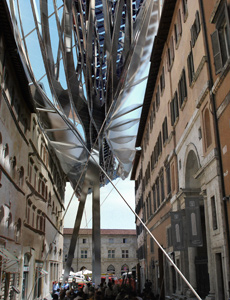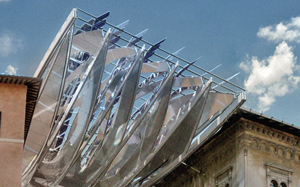 |
 |
 |
 |
 |
 |
| |
 |
|
 |
 |
 |
  |
  |
 |
 |
 |
 |
|
|
 |
|
 |
 |
 |
BUILDING |
 |
|
 |
|
 |
 |
 |
| |
 |
| 
 |
Energy Roof
|
|
 |
 |
 |
 |
DESIGNER |
 |
|
|
 |
|
 |
 |
 |
| |
 |
|
 |
 |
 |
 |
DESCRIPTION |
 |
|
|
 |
|
 |
 |
 |
| Location |
 |
|
 |
| The new glass gallery along Via Mazzini in the center of Perugia covered by the Energy Roof creates the entry point to the archaeological underground passage that connects the city center with the mini metro station Pincetto. |
|
 |
 |
 |
|
 |
|
| Urban Strategy |
 |
|
 |
| By means of a glass gallery along Via Mazzini, a new public space and attractor is created. The place is defined by its history, dynamic circulation flows and urban liveliness. The new paradigmatic design of the Energy Roof creates a distinctive and highly recognizable icon for the city and a statement for aesthetic sustainability corresponding with the ancient buildings of Via Mazzini. It assigns the entrance to the archaeological underground passage leading through the history of Perugia. |
|
 |
 |
 |
|
 |
|
| Walking through history |
 |
|
 |
| The underground passage is not only a shortcut in between the city center at Via Mazzini and the arrival point of the Mini Metro station Pincetto but also an exhibition space. Historical documents show the existence of the old Etruscan city wall in the area bellow Piazza Giacomo Matteotti which COOP HIMMELB(L)AU proposes to excavate as part of an underground public gallery space exhibiting the history of Perugia. Controlled views and look-out points make orientation easy. Openings in the ground of the Piazza Giacomo Matteotti visually connect the underground passage with the Energy Roof. |
|
 |
 |
 |
|
 |
|
| Structural description (preliminary) |
 |
|
 |
 The roof consists of three layers with the structural layer in the middle. The other two layers are the energy generating layer on the top and the glazing layer on the bottom. In the summer, the east wing of the roof, forming a rotor blade, captures wind, thus providing air ventilation for cooling. The structure therefore has to be sufficiently ‘open’ to drive the fresh air to the street level from above. The roof consists of three layers with the structural layer in the middle. The other two layers are the energy generating layer on the top and the glazing layer on the bottom. In the summer, the east wing of the roof, forming a rotor blade, captures wind, thus providing air ventilation for cooling. The structure therefore has to be sufficiently ‘open’ to drive the fresh air to the street level from above.
The roof structure is approximately 80 meters long supported by a tripod in the middle. There are ten members connecting the roof structure and the tripod. The structure, forming a rotor blade, is 16 meter s wide at the ends while in the middle part, around the supporting points, the roof slims.
The geometry of the structure is determined by crossed planes that are arrayed in longitudinal direction. The intersection of the planes and the geometry of the ‘propeller’ describe the perimeter of the load bearing structure. To provide the sufficient air-ventilation and to reduce the self-weight of the structure holes are cut in the plane of the planes in a way that the remaining areas are connected and are performing as a rigid and optimized composition. These connected planes consist of single beams and act as trusses.
There are four, ca. 80 meter long main frames going from one end to the other that provide the sufficient supporting capacity. Six other frames can be found at both sides of the structure that provide the rigidity of the geometry. The main and the secondary trusses are connected by perpendicular frames. If the trusses will be covered, the air ventilates through the openings that can be found in the main and secondary frames.
To avoid tilting or rotating around the tripod, the construction is stabilized by tension bars on both sides. These are placed within the area of the streets and therefore avoid introducing any loads into the historical buildings.
In addition to dead load and snow the ruling loads are the wind loads and those resulting from earthquakes, which are considerably high in Perugia with around 0,26g.
Text edited by Coop Himmelb(l)au |
|
 |
 |
 |
 |
 |
 |
 |
ECO-SUSTAINABILITY |
 |
|
|
 |
|
 |
 |
 |
| Features of energy |
 |
|
 |
The roof design is driven by the generation of energy for the city. While the orientation of the west wing is optimized in relation to solar radiation, the east wing captures wind. The roof consists of 3 layers: the energy generating top layer, the structural layer in the middle and a layer on the bottom as a combination of laminated glazing and translucent pneumatic cushions.
The top layer includes transparent photovoltaic cells to generate electricity and shade the sun. The orientation of the individual cells is generated and optimized by a computer driven scripting program. Furthermore 5 wind turbines that are placed inside the structural layer are generating additional energy. Both the roof and the underground passage are energy self-sufficient. |
|
 |
 |
 |
|
 |
|
| Energy production |
 |
|
 |
 During the design process of the energy roof a special focus has been put on using photovoltaic cells as functional and aesthetic elements. During the design process of the energy roof a special focus has been put on using photovoltaic cells as functional and aesthetic elements.
To maintain visual connections to the surroundings we propose to use frameless glass elements with integrated transparent photovoltaic cells for the top layer of the roof. Therefore sun-shading, energy generation and architectural integration are all combined in one element.
The chosen geometry of the panels follows the overall shape of the Energy Roof, and curved lines made of photovoltaic cells are created. The photovoltaic elements are peeling off the surface and tilted towards the sun where the roof area is oriented to the North East. The resulting gaps are closed by passive glass panels which appear similar to the active panels.
This installation creates a photovoltaic energy generator with a performance of around 73 kWp. The annual output of 100 MWh provides a major contribution to environmentally friendly generation of energy.
With the wind turbines and an additional performance of around 25 kWp a peak performance of around 100KWp is reached.
Text edited by Coop Himmelb(l)au |
|
 |
 |
 |
 |
 |
 |
 |
LOCATION |
 |
|
|
 |
|
 |
 |
 |

|
 |

|
Continent |
|
 |
|
Nation |
|
 |
|
Region |
|
 |
|
Province |
|
 |
|
Town |
|
 |
|
Address |
|
 |
|
|
|
 |
|
 |
 |
 |
 |
MAP |
 |
|
|
 |
|
 |
 |
 |
| |
 |
|
 |
 |
 |
 |
|
TYPOLOGY |
 |
|
|
 |
|
 |
 |
 |
|
|
 |
ARCHITECTURE | Other architectural structures
Galleries and Arcardes
| |
 |
 |
 |
 |
CHRONOLOGY |
 |
|
|
 |
|
 |
 |
 |
Project |
 |
|
 |
| 
 |
2009
project winner of competition
|
|
Realisation |
 |
|
 |
| 
 |
2010 - 2012 |
|
 |
 |
 |
 |
BIBILIOGRAPHIC REFERENCES |
 |
|
|
 |
|
 |
 |
 |
|
 |
| Paolo Ansideri, "Il coraggio dell'architettura: camminare nella storia", Corriere dell'Umbria, 4 febbraio 2010 [interview with Wolf Prix] |
|
 |
 |
 |
 |
 |
 |
 |
CLIENT |
 |
|
|
 |
|
 |
 |
 |
| |
 |
| Università degli Sudi di Perugia/ Dipartimento di Ingegneria Civile e Ambientale |
|
 |
 |
 |
 |
DIMENSIONAL
DATA |
 |
|
|
 |
|
 |
 |
 |
| Lenght |
 |
|
 |
|
| Widht |
 |
|
 |
|
 |
 |
 |
 |
STRUCTURES |
 |
|
|
 |
|
 |
 |
 |
| |
 |
| B+G Ingenieure, Bollinger und Grohmann GmbH, Frankfurt |
|
 |
 |
 |
 |
STAFF |
 |
|
|
 |
|
 |
 |
 |
Project  |
 |
COOP HIMMELB(L)AU
Wolf D. Prix / W. Dreibholz & Partner ZT GmbH |
|
|
 |
|
|
 |
|
Project architect |
 |
|
Partner |
 |
|
Design architects |
 |
|
Design team |
 |
| Robin Heather, Daniel Reist, Anja Sorger, Jenny Chow, Luis Ferreira |
|
Plastic models, rendering, visualization |
 |
|
Architect of record |
 |
| Heliopolis 21, San Giuliano Terme |
|
Energetic plants |
 |
| Baumgartner GmbH, Germany |
|
 |
  |
 |
|
|